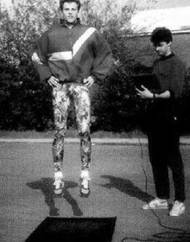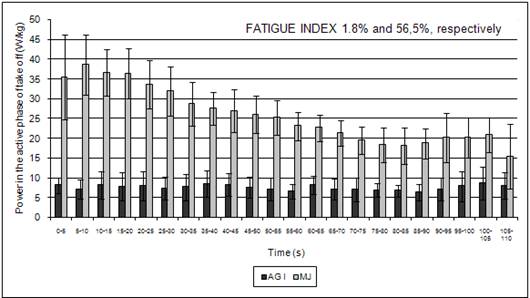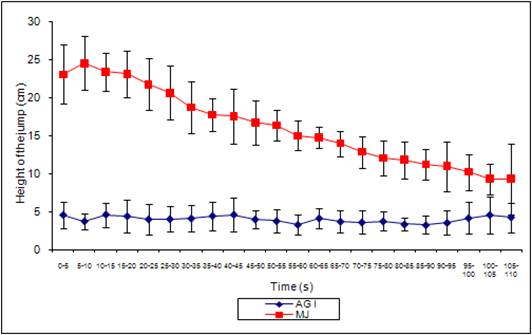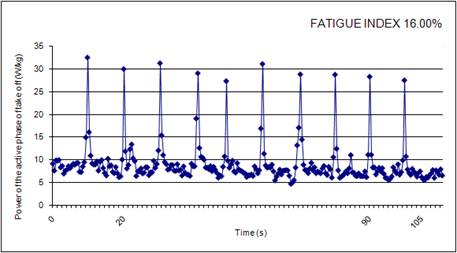MODIFIED AEROBIC GYMNASTICS ROUTINES IN COMPARISON WITH LABORATORY TESTING OF MAXIMAL JUMPS
Kyselovičová Oľga, Zemková Erika
Faculty of Physical Education and Sports, Comenius University, Bratislava, Slovakia
Abstract
The study compares power in the active phase of take off and height of the jump in maximal and during a modified aerobic gymnastics routine. A group of 5 junior gymnasts (mean age 17.2 ± 1.64 years, height 161 ± 6.48 cm, weight 52.4 ± 6.43 kg and BMI 20.16 ± 1.42 kg.m2) underwent in random order a 1.45 min maximal jumps (MJ) and two trials of modified aerobic gymnastics routines (AG I - high impact aerobic routine without difficulty elements, and AG II – high impact aerobic routine with combination of aerobic jumps in every 10 seconds), respectively. The diagnostic system FiTRO Jumper consisting of a special contact switch mattress connected by means of an interface to a computer was used. Jump parameters (power in the active phase of take off and height of the MJ, AG I and AG II) were calculated from the flight and contact times. Results showed that subject achieved the highest value in MJ test. In contrary, during the second aerobic gymnastics trial (AG II) the power in active phase of take off was almost the same as in the MJ trial, but in combination of high impact aerobics and aerobic jumps (AG II) the examined subjects were able to perform maximal power during the test with only slight decrease about 2%. It may be concluded that evaluation of modified aerobic jumps reflect better sport-specific performance. However, test of maximal jump should provide additional information on anaerobic capacity of examined subject.
Key words: aerobic gymnastics performance, explosive power of lower limbs, sport-specific aerobic gymnastics testing
INTRODUCTION
In recent years aerobic gymnastics progressed rapidly in technique and artistic performance as well (Mineva, 2004). As it is non- Olympic discipline, this sport underwent continuous changes (Righetti, et al., 2006), but despite of more than 10-years history there is still limited information about the effect of the specific training in many aspects (Bacharová, et al., 2007; Kyselovičová, et al., 1999; Kyselovičová & Tibenská, 2007). Explosive power is one of the most significant factors in aerobic gymnastics performance. The gymnast must be able to demonstrate intensive, dynamic, rhythmic and continuous sequences of high and low impact aerobic movements with perfectly executed difficulty elements throughout the 1.30 – 1.40 min routine. Therefore, the aim of the present study was to compare power in the active phase of take off and height of the jump in maximal and during modified aerobic gymnastics routines.
METHODS
A group of 5 junior gymnasts (mean age 17.2 ± 1.64 years, height 161 ± 6.48 cm, weight 52.4 ± 6.43 kg and BMI 20.16 ± 1.42 kg.m-2) underwent in random order a 1.45 min maximal jumps (MJ) and two trials of modified aerobic gymnastics routines (AG I - high impact aerobic routine without difficulty elements, and AG II – high impact aerobic with combination of aerobic jumps in every 10 seconds), respectively.FiTRO Jumper (Fig. 1) consisting of a special contact switch mattress connected by means of a special interface to a computer was used. The system measures contact and flight times (with accuracy of 1ms) during serial jumps and calculates basic biomechanical parameters. The reliability of the test has been proved to be enough (Tkáč, et al., 1990) to be applied in functional diagnostic of jump performance in athletes.

Fig. 1 FiTRO Jumper – a PC based system for the assessment of explosive power of lower extremities
For the assessment of explosive power of lower extremities a test of 10-seconds maximal jumps with hands fixed on the hips in order to minimize the influence of upper extremities was employed. Two trials with two minutes of pause after each were performed. A better score was being taken for evaluation. The most reliable parameter has been found to be power in the active phase of take off in watts per kg of body weight expressed as a mean of the three maximum values of a jumping sequence (Tkáč, et al., 1990). The power output in the active phase of take off expresses in fact the capability to take off with the highest intensity, in the shortest time. According to research date, this capability is to a high degree conditioned by proportion of fast muscle fibres. Furthermore, a method of modified aerobic gymnastics routines (without and with difficulty elements) in duration of 1.45 min was applied. Besides qualification of power in the active phase of take off and height of the specific high impact aerobic movements (e.g. jogg, jumping jacks, hoops, etc.), also fatigue index expressed as a ratio of power decline (Pmax-Pmin/Pmax) was calculated.
RESULTS AND DISCUSSION
The results compare jump parameters and fatigue index during 1.45 min trials of maximal jumps and modified sport specific aerobic gymnastics routines. As expected, the power in active phase of take off during the maximal jump test (MJ) shows declined tendency (from 38.73 to 15.53 W/kg), while the curve of this parameter in first aerobic gymnastics trial (AG I) is smooth from start (8.25 W/kg) to finish (8.1 W/kg), with no dramatic increase in power (Fig 2). These findings are supported also by fatigue index 56.5% and 1.8%, respectively. Not surprisingly, comparison of the height parameters during MJ and AG I trials has shown identical tendencies as in the power parameters (Fig 3). In contrary, during the second aerobic gymnastics trial (AG II) the power in active phase of take off was almost the same as in the MJ trial (Fig 4), with the highest value of 32.62 W/kg. Interestingly, in combination of high impact aerobics and aerobic jumps (AG II) the examined subjects were able to perform maximal power during the test with only slight decrease of 2% (Fig 5). Fatigue index 16,00% in AG II indicates increase in maximal power and better reflects sport specific performance in comparison with AG I (1.8%). Intra-individual differences have shown that top-level aerobic gymnasts performed much power with less fatigue throughout the trials than the weakest ones. Similar results have been found in previous research (Zemková & Hamar, 2005).

Fig 2 Power in the active phase of take off and fatigue index during 1.45 min MJ and AG I

Fig 3 Height of the jump in the active phase of take off during 1.45 min MJ and AG I.

Fig 4 Power in the active phase of take off and fatigue index during 1.45 min AG II.
CONCLUSION
These findings indicate that evaluation of modified aerobic jumps reflect better sport-specific performance, and very probably also training adaptation in aerobic gymnasts compared to maximal jumps used in laboratory testing. Such a sport-specific testing should be recommended. However, test of maximal jump should provide additional information on anaerobic capacity of examined subject.
LITERATURE
- Bacharová, L., Tibenská, M., Kučerová, D., Kyselovičová, O., Medeková, H, Kyselovič, J., 2007. Decrease In QRS Amplitude In Juvenile Female competitive athletes during the initial twenty-one months of intensive training. Cardiology Journal, 14 (3), pp. 260-265.
- Kyselovičová, O., Klimas, J, Vadovičová, B., 1999. Changes of heart rate and ECG in specific conditions of training process in aerobic gymnastics. Acta Facultatis Educationis physicae Universitatis Comenianae, 40. Bratislava: Univerzita Komenského, pp. 177-184.
- Kyselovičová, O., Tibenská, M., 2007. Heart rate as an indicator of load intensity in aerobic gymnastics training sessions during the specific preparatory period for the World championships. In: Optimalizácia zaťaženia v telesnej a športovej výchove na rozličné formy pohybového zaťaženia. Bratislava: Slovenská technická univerzita, pp. 95-99.
- Mineva, M., 2006. Specific tendencies of development in aerobic gymnastics. Telesná Výchova & Šport., 16 (2), pp. 35-37.
- Righetti, L., Piacentini, M.F., Capranica, L., Felici, F., 2006. Energy sources for aerobic gymnastics competition routines. Rivista di Cultura Sportiva, XXIII (62-63), pp. 83-86.
- Tkáč, M., Hamar, D., Komadel, Ľ., Kuthanová, O., 1990. Measurement of anaerobic power of the lower limbs by a method of repeated jumps. Sports training, Medicine and Rehabilitation.,1, pp. 317-325.
- Zemková, E., Hamar, D., 2005: Characteristics of take off abilities of athletes of various spesialisation. Telesná Výchova & Šport., 15 (1), pp. 42-44.
MODIFIKOVANI SPORTSKI AEROBIK U POREĐENJU SA LABARATORIJSKIM TESTIRANJEM MAKSIMALNIH SKOKOVA
Originalni naučni rad
Sažetak
Istraživanjem se komparira snaga aktivne faze skoka i visina skoka pri izvedbi maksimalnog i modifikovanog sportskog aerobika. Pet juniora (godine 17.2 ± 1.64, visina 161 ± 6.48 cm, težina 52.4 ± 6.43 kg, BMI 20.16 ± 1.42 kg.m2) je nasumičnim redoslijedom izvelo. maksimalne skokove (MJ) u trajanju od 1,45 min i dva testa modifikovanog sportskog aerobika (AG I – visokointenzivna izvedba bez teških elemenata, I AG II visokointenzivna izvedba sa kombinacijom aerobic skokova svakih 10 sekundi). Za testiranje je korišten FiTRO Jumper sistem koji se sastoji od kontaktnog tepiha koji je povezan sa računarom. Parametri skoka (snaga u aktivnoj fazi skoka, visina MJ, AG i, AG II) su izračunati pomoću trajanja leta i kontakta). Rezultati su pokazali da su ispitanici dostigli najveće vrijednosti u MJ testu. Suprotno, za vrijeme testa AG II snaga aktivne faze skoka je bila skoro ista kao i kod MJ testa, ali u kombinaciji sa visokointenzivnim aerobikom i aerobik skokovima (AG II) ispitanici su bili sposobni da za vrijeme testa ispolje maksimalnu snagu samo sa malim padom od 2%. Može se zaključiti da procjena modifikovanih aerobik skokova bolje odražava sportsko-specifičnu izvedbu. Kako god, test maksimalnih skokova treba osigurati dodatne informacije o aerobnim kapacitetima ispitanika.
Ključne riječi: izvedba sportskog aerobika, eksplozivna snaga donjih ekstremiteta, specifični test sportskog aerobika
Corresponding author:
Doc. PaedDr. Oľga Kyselovičová, PhD.
Position: associated professor
Address: Faculty of Physical Education and Sports, Comenius University
Department of Gymnastics
L. Svobodu 9,
814 69 Bratislava, Slovakia
Phone: 00421 903 22 75 82
Fax: 00421 02 544 1909
e-mail: kyselovicova@fsport.uniba.sk